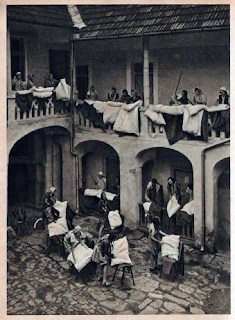Mariazell is an Austrian city in the southeastern state of Styria. Well known for being a hub of winter sports and a pilgrimage destination, it is located 143 kilometres (89 miles) north of Graz. It is picturesquely situated in the valley of the Salza, amid the north Styrian Alps.
It is a site of pilgrimage for Catholics from Austria and neighboring countries. The object of veneration is an image of the Virgin Mary reputed to work miracles, carved in lime-tree wood. This was brought to the place in 1157, and is now enshrined in a chapel adorned with objects of silver and other costly materials. The large church of which the chapel forms part was erected in 1644 as an expansion of a smaller church built by Louis I, King of Hungary, after a victory over the Ottoman Empire in 1363.
On many occasions, I've visited Mariazell with my mother, Gertrude, who was in the BDM. Her story can be found HERE.
The following photos are from Jugend im Reich, Adolf Schmidt - 1942
Drei Hufeisen pg. 129
Hotel Lauffenstein - page 113
Mariazell Basilica - page 115
KLV Instructor in Mariazell teaching a young girl how to wash and rinse the towel.
Steirmark Austria - Styria is a mountainous, forested state in southern Austria, known for its wine, spas and castles. Graz, the riverside state capital, blends Renaissance and baroque architecture with modern designs such as Murinsel, an artificial island made of glass and steel, and the alienlike Kunsthaus, a contemporary art museum. A funicular runs up Schlossberg, a hill topped by the Uhrturm, a 16th-century clock tower. Gemeinde Alpe - page 100 from Jungend in Reich, Adolf Schmidt - page 100
Zum grünen kranz - pages 24, 25,
Pages 98 - 99
Page 104
Page 107, 138





















